“They call themselves the Silent Defenders.”
So began a fascinating exposé under the banner of “Backlash of Hate” in the Sunday Mirror 19th March 1972 on the little known and less remembered Loyalist Silent Defenders.
“They train in secret and are dedicated to revenge against the IRA [Irish Republican Army].”
But the reporter, Kevin Dowling, at the time wrote it was “an unnerving experience” as he was blindfolded and driven by hooded, armed men to a clandestine meeting with other hooded, armed men up a desolate country road.
It was also a meeting, Dowling writes, that was “arranged by a Protestant of high professional standing”, who wanted, “to show the world the realities of Protestant power.”
The Silent Defenders, he was told, was made up of former British soldiers and a few B-Specials, the Ulster Special Constabulary force disbanded less than two years before.
“In a whitewashed barn decked out with Ulster flags, Union Jacks and pictures of the Queen, their leader in charge of this meeting sat at an old table. He pressed a button on a tape recorder. A voice boomed out.”
“I address you as the commander in chief of the organisation, Silent Defenders.”
He issued threats against the IRA, Harold Wilson (former British Prime Minister and Labour leader), James Callaghan (future British Labour Prime Minister) and “Tory traitors”.
Three days later, the British Prime Minister and Tory leader, Edward Heath told the Northern Ireland Prime Minister that he was proroguing Northern Ireland’s Stormont Parliament and ruling directly from Westminster. Stormont was duly prorogued on 30th March 1972 and thus it remained till 1998.
History does not record any revenge attacks by the Silent Defenders.
But their story may not have ended that night.
SECRET BRITISH ARCHIVES
In the Sunday Mirror article, a senior Army source is quoted:
“There are several organisations very similar to the one you describe working at the moment. This is the first time we have met the name Silent Defenders… You are the first person to have made direct physical contact with an armed Protestant cell.”
We know, of course, that the last sentence is nonsense as the British Army was not only in direct contact with armed Protestant cells but also at pains to portray the violence as one-sided and potential Loyalist violence as a “backlash” against IRA violence. The highly discriminatory Internment policy against the Irish Catholic community alone had failed and Protestant extremists had killed around 31 people by then including the 15 civilians in McGurk’s Bar in December 1971. British Army agents had also infiltrated the groups and currently serving British soldiers were training and arming them.
Indeed, Paper Trail has discovered various references to the Silent Defenders in secret British military intelligence files and Situation Reports from the period.
A British Army Intelligence Summary from July 1972 recorded:
20. The extreme Protestant group, known as the Silent Defenders, are considering intensive military action if the Secretary of State does not take effective measures against Catholic No Go areas. According to a statement made to a Northern Irish republican newspaper they called on ‘all loyalists to give every assistance to the UDA volunteers on the weekend of 2nd of July and if this feels to bring sanity to the Westminster government then intensive military action must and will be considered.’ The only other reported activity of the Silent Defenders was a feature scoop in the Sunday Mirror at the end of February [sic] describing their clandestine activities. The same group are thought to have been responsible for the ‘10,000 men secret Protestant militia’ article in the Daily Telegraph on 29th of April. (The UDA claim an active membership of 43,000) …”
“28. a. [William] Craig, speaking in Belfast on 6 July, said that there were in Ulster 4 or 5 armed ‘Commando type’ organisations existing alongside the UDA [Ulster Defence Association]. These ‘commandos’ were, he said, prepared to carry out ‘special duties’ and “people belonging to them have military experience.” There have also been indications of other ‘special groups’ within UDA appearing over the past month, including:
(1) UDA police…
(2) UDA ASUs [Active Service Units]
(3) Assassination Squads
b. It is probable that there are also a number of freelance extremist groups including those who call themselves UVF [Ulster Volunteer Force], and the Silent Defenders, varying in numbers from 5 to 50 who might assume the mantle of judges, juries and executioners.”
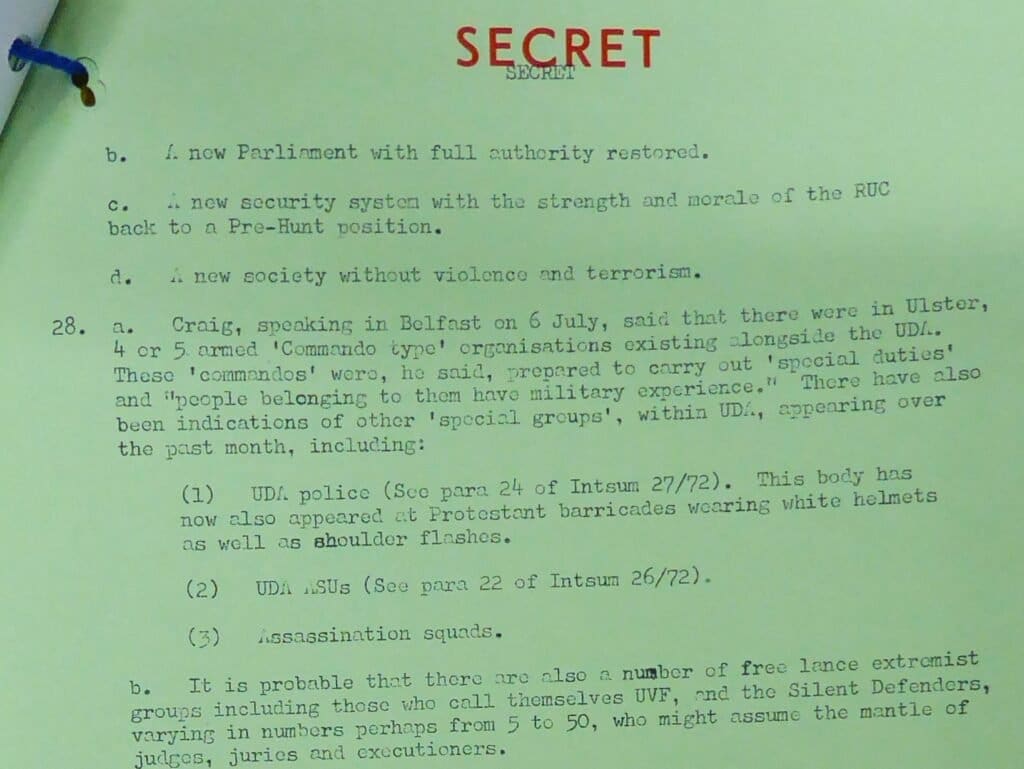

July 1972 was to the most violent month of the conflict and all sides guilty of the carnage although only Irish Catholics were being interned without trial. By the time alleged Protestant extremists were interned in February 1973 – and even then comparatively few – Loyalists had killed around 120 civilians. The UDA, of course, was not even proscribed until August 1992 and after it had killed hundreds of civilians.
Another British Army Intelligence Summary at the end of the month:
“A significant incident took place in the area of Unity, were three Protestants in a car fired on a group of Catholics. They subsequently crashed and were taken into custody.”
Comment. They were members of a group who called themselves the Silent Defenders. REDACTED had a UDR ID [Ulster Defence Regiment Identification] card and REDACTED had a previous trace as a member of the UVF with the number of unexplained shooting incidents having taken place the capture of these three during this incident may through some light on the others.”
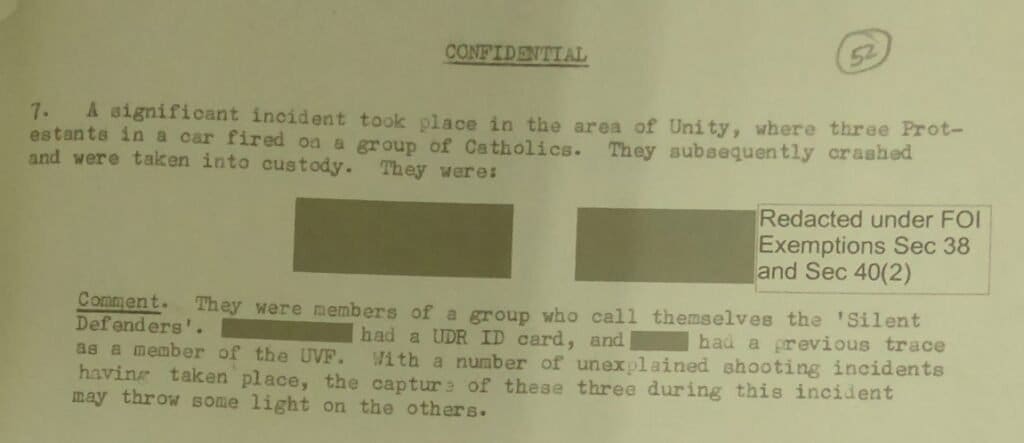

The report of the incident related to the shooting of student Joseph Henry Hall who was walking home after a night out. As he walked past the Unity area of North Belfast which is an Irish Catholic area, a van pulled up and one of the Loyalists asked him directions; but they then shot him 10 times and left him for dead.
Miraculously he survived.


As the shooters tried to escape to the Crumlin Road, they blundered into a Royal Marine 40 Commando patrol – RUC personnel were at the scene too just over an hour after the 39 Brigade Commander contacted 40 Commando:
“RUC are frightened in your area. Offer to take them around occasionally in your Saracens”


The driver of the van, Thomas Reid, panicked, when the Commandos took up firing positions. He lost control of the vehicle and crashed, injuring them all. The three Loyalist gunmen were captured.
The other two were Ronnie “Flint” McCullough and William “Plum” Smith who became well-known Loyalists. In his recent autobiography, leading Loyalist Billy Hutchinson (with Gareth Mulvenna) wrote that McCullough had been “instrumental in organising other young men into the Red Hand” and that he was “the driving force behind cementing the relationship between the UVF and the Red Hand.”
Not only is it very interesting that the British Army connect the shooters to the Silent Defenders, although we now know they were members of the Red Hand Commando, but the British Army also records that at least one is a British soldier of the Ulster Defence Regiment with a UDR card.
A Special Investigations Branch report to British Army 39 Brigade Headquarters recorded “UDR men” and named two of the three it appears.


I can find no reference that the UDR membership was falsified or out-of-date.
This is the first time that UDR involvement has been published as it was not recorded at the trials, reported in the papers or in local histories.
Desmond Boal was the lawyer for the three Loyalists. The Belfast Telegraph (7th December 1972) reported Boal told the court:
“They are subjected to the same social pressures and are swayed by the same prejudices and mindlessness and thoughtlessness that permeates that section of the community.”
Although Justice O’Donnell sentenced them to 10 years:
“he accepted that they were swayed by passions influenced by events and people more mature than themselves – passions which they inadequately understood.”
He said that he would have considered a life sentence if they were older, wiser and more mature. They were 22, 20 and 18 at the time.
I cannot find any reference to UDR membership in the news reporting of the prosecution although we find in many cases that UDR membership was either not admitted publicly at court or to the prosecution (and thereby not reported) or that the Loyalists were recorded as ex-members of the UDR by the time of their trial.
Martin Dillon and Denis Lehane cover the incident in Political Murder in Northern Ireland and they too like Boal contrast the average working class, Loyalist background of the three with their subsequent violent extremism and sectarianism, but do not refer to British Army membership.
Gareth Mulvenna references this text in Tartan Gangs and Paramilitaries and interviewed McCullough for his own book. Nevertheless, the closest reference I can find there refers to McCullough’s “involvement with the UDR” but nothing (unless I have missed it) regarding his actual membership of the UDR at the time of his arrest for the attempted murder which is obviously important considering McCullough’s position within RHC and the development of the paramilitary group.
INFORMATION BATTLE
Paper Trail accessed these particular Brigade logs and Situation Reports following a prolonged information battle and Public Interest test which took years. They show that the British Army’s Royal Military Police (RMP) were investigating.
No doubt RMP was tasked as the Royal Marines being involved in their capture, but also – it appears – because the British Armed Forces discovered at least one British soldier was involved in shooting the unarmed civilian.
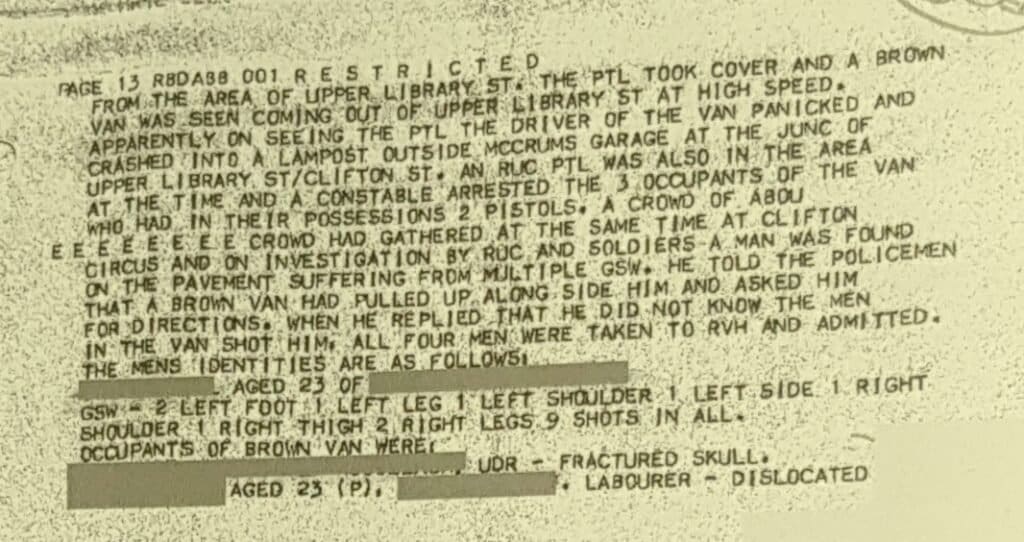

Dual membership of UDR and an extreme Loyalist group may surprise some readers less than the report that British military intelligence did not have more information relating to the Red Hand Commando.
As Paper Trail examined previously, the British Army’s Intelligence Summaries (INTSUMs) from the time show the development of extensive files on Loyalist paramilitaries from the ground up and, of course, it had well-placed agents.
In fact, the same INTSUMs record:
“The leaders are comparatively open about their organisation and consequently a large number of names have been forthcoming. They state that there is nothing illegal about their activities although there are undoubtedly weapons close at hand.”
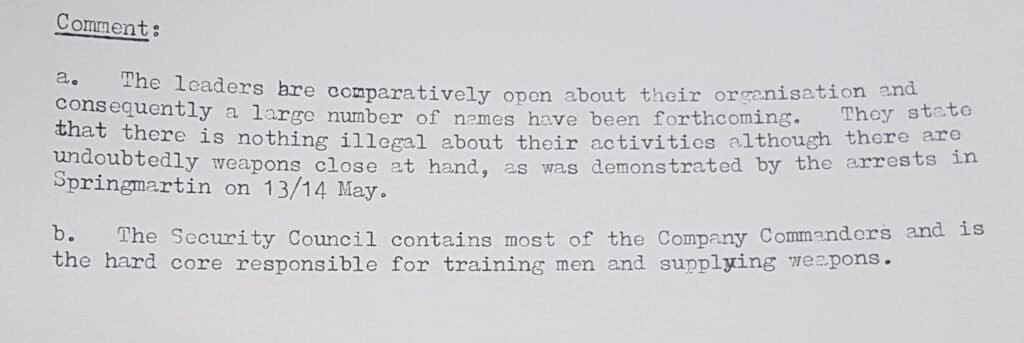

So, whilst individual RHC members may have been more secretive and security-conscious, other Loyalists in their area were not.
Dual membership of the British Army and a Loyalist extremist group also opens the debate as to which organisation is infiltrating the other. Loyalists, for example, could argue that they infiltrated the UDR for training and information and were not being run as agents of the state.
Interestingly too, the subsequent British military Intelligence Summary also connects this Loyalist/British Army unit to other unexplained shooting incidents in the area including an attempted mass murder a few nights before.


Nevertheless, there were other death squads stalking the area as we will see.
DRIVE-BY SHOOTINGS
The previous month, groups of teenagers were shot at in North Queen Street/Gt. George Street from passing cars. On 5th June, 2 were injured. On 16th June, 1 was injured. On 23rd June, teenager Patrick McCullough was murdered at Antrim Road/Newington. All of these were in 40 Commando's area.
40 Commando was also involved in a number of contentious shootings at this very time in the area. Its snipers shot IRA men Seamus Cassidy on 28th July and Jim McCann the following night 29th July - both in New Lodge.
The Marines alleged they were gunmen but locals denied this. McCann was shot in the back but survived and was not arrested. He was killed a few months later when he became one of the victims of the British Army's New Lodge Six Massacre.
I believe that the files above refer directly to a drive-by shooting nearby at Carrick Hill a few days before Joseph Hall’s shooting.
On 24th July, around quarter to eleven at night, 3 teenagers aged 16 were shot from a passing white Cortina, under the nose of Royal Marine 40 Commando observation posts and sangars in the area. The British Army logged 10 – 12 shots fired at the teenagers from 2 submachine guns but local witnesses say many more.


One of those who was injured believed the attack to be a professional British Army hit although not necessarily one like the panicked Loyalist/UDR unit which shot Joseph Hall.
A British Army Situation Report the following morning alleged that the 3 victims were members of the Fianna [youth wing], Official IRA, but did not allege they were armed and did not arrest them.
These allegations, though, might then point towards a deliberate targeting of the teenagers that night rather than a random drive-by, although the shooters had a particular interest in one who was hit in the abdomen and chest but still managed to get up after crumpling on to the ground, run zig-zag, and escape a trail of bullets behind him. He remembers:
"I was already on the ground face-down before I heard the shooting. It was only when a bullet went through my shoe and lodged between two toes - burning me - that I realised I was hit. Then I tasted the blood."
The Commandos had been harassing him that month too.
The other victims were hit in the feet and legs and could not run but were left lying on the ground as the shooters continued to fire over them at the fleeing victim.
The British Army did not claim this drive-by shooting or any of the others above in these files but an offensive, covert, extra-legal British Army unit cannot be discounted either.
PSEUDO GANGS
Not only do we know that individual British Army battalions ran their own covert mobile “Q Patrols,” or pseudo gangs, and their operations could result in civilians being targeted and shot – such as the attempted assassination of the Conway brothers by an undercover unit of the Kings Own Scottish Borderers on 15th April 1972; but we also know that the British Army had deployed the extra-legal Military Reaction Force in Belfast, and its units had murdered and maimed civilians in West Belfast.
You can read about these in our report, Shooters: Britain’s Military Reaction Force [PDF].
We also know from Paper Trail’s extensive British military archives that MRF units deployed in this very area of City Centre and North Belfast although the files may not tie the MRF directly to these offensive attacks (as we proved they did in West Belfast).
Some commentators may proffer that the West Belfast MRF units were “out of control” and the City Centre/ North Belfast MRF units did not deploy the same shoot-and-scoot attacks on civilians but maintained their surveillance role alone. Indeed, even before the recent death of MRF killer, Clive “Taff” Williams, many laid much of the blame on him specifically and his unit.
Nevertheless, the MRF’s Commander at the time, Captain James Alistair McGregor was in the car when Williams shot 4 civilians at the bus terminus on Glen Road on 22nd June 1972. The non-standard Army issue Thompson machinegun Williams used, was actually McGregor’s, and the bullets were from RUC stores.
Hardly out of control if your Commander is sitting beside you when you shoot civilians.
Interestingly, these particular Brigade files do actually reference a report by 40 Commando, a secret signal and the MRF less than half an hour before the teenagers were shot.
“2220 [ 10:20pm] Ref[erence] immed[iate] secret signal 242010Z (24th July 10:10pm Z). Contacted on this on other means. The SDS Det is employed by the MRF.”


SDS Det here is Signals Dispatch Service Detachment of Royal Corps of Signals which carried messages between Battalions and Headquarters. There is no reference at 10:10pm in these logs regarding this secret signal, but it may lie in an annex of this file retained by the British Ministry of Defence. We do know that the MRF is operating in north Belfast and as far up as Ligoniel.
Just that morning at 10:50 am, 45 Commando of the Royal Marines complained to Brigade:
“Ref[erence] MRF: They have been Op [operating] in our area last few days but have made no liaison with us despite being told to do so on several occasions.”


Other British Army files we found record that all of the MRF’s tasks are to be cleared by the Brigade Commander:
“the CO [Commanding Officer] of the unit in whose area the op[eration] will take place is to be info[rmed] by the OC [ Officer Commanding] MRF that the MRF is op[erating] in his area and the details of the op[eration].”
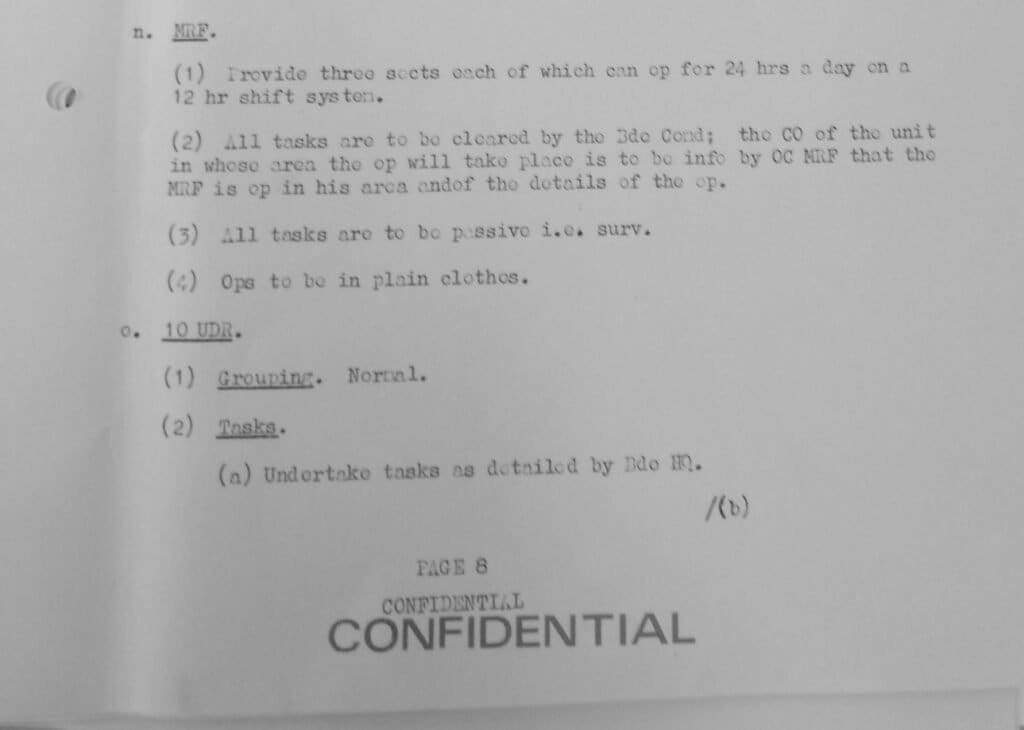

Even with the potential for friendly fire aside, the Commander of the elite Royal Marines is correct to complain that an undercover unit - and not his own - is operating somewhere in his command area, although the same file records that:
“All [MRF] tasks are to be passive i.e. surv[eillance].”
As discussed above, we know that the MRF was involved in many offensive actions against unarmed civilians.
We have also examined how surveillance and information gathering was only one face of the MRF COIN. The other was contact and offensive operations.
STARING INTO THE ABYSS
July 1972 was the bloodiest month of the whole conflict with 95 killed and thousands injured. These particular Brigade files cover scores of these killings and Paper Trail has spent the last number of years working with many of the families who lost loved ones during these four particularly horrific weeks.
The files prove that no side can claim the myth of blamelessness as paramilitary organisations, uniformed state forces, extra-legal state forces and mixed units were all guilty of the mayhem including some of the most heinous atrocities during the conflict such as the Claudy, Bloody Friday and the Springhill-Westrock Massacres.
Any investigations of those that remain unclaimed or apparently “motiveless” - as the state recorded - should also consider the involvement of extra-legal British Army units like the MRF or hybrid counter-gangs involving British Army/UDR members and Loyalist extremists.
Murder Mile from New Lodge to Cliftonville in North Belfast was so-called as it was a favoured hunting ground for Loyalists on the prowl for easy Catholic civilian targets. It may also be no accident that Murder Mile skirted Girdwood Barracks, home to 10 UDR which files discovered by the Pat Finucane Centre proved was heavily infiltrated by Loyalist extremists although the British Ministry of Defence turned a blind eye.
Unfortunately, though, such investigations are more difficult when the state routinely buried evidence, failed to admit that it prosecuted UDR members or has since destroyed all files relating to its death squad [as alleged by the Kenova team].
As for today’s so-called reformed Police Service of Northern Ireland (PSNI), its Operation Everson team is not investigating any other shootings by the MRF other than those which occurred in West Belfast alone.
Nevertheless, as proved by its failed investigation into the murder of Jean Smyth-Campbell in June 1972, it is moot whether the PSNI is practically independent enough to investigate any legacy killing, especially those involving state killers. In Jean’s case, the British Supreme Court agreed.
In the meantime, Paper Trail has submitted a number of shootings it is investigating in North Belfast to Jon Boutcher’s Kenova team as we believe the murderous activities of Britain’s paid and decorated Silent Defenders – the Military Reaction Force – need properly and independently investigated across Belfast at the very least so we can have a better measure of the impact its shooters had in helping us slip towards outright civil war in the summer of 1972.
We have no faith that Britain's latter-day Silent Defenders in PSNI will offer any fair or just investigation in that regard.
RELATED INFORMATION
Read "Backlash of Hate" by Kevin Dowling in the Sunday Mirror, March 1972
Read Paper Trail's Shooters: Britain's Military Reaction Force
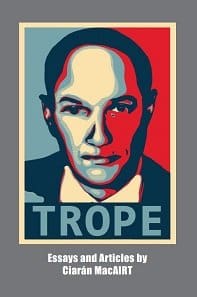

Trope: Essays and Articles
by Ciarán MacAirt.
These essays and articles represent a personal journey, and find him trudging from the killing fields of World War 1 to the back streets of Belfast where death squads prowled.
All of the profits from the sale of this book are donated directly to the charity, Paper Trail, to help fund its work with victims and survivors of the conflict in Ireland and Britain.



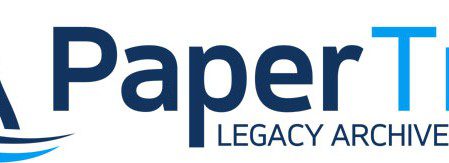
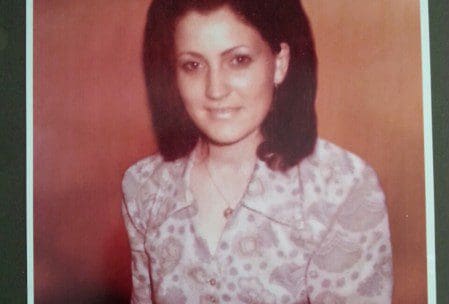
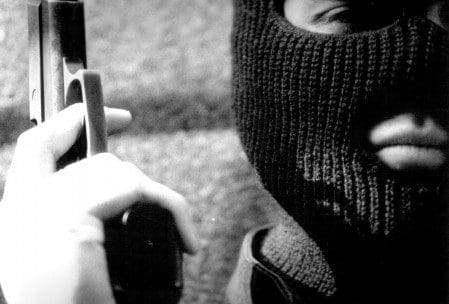
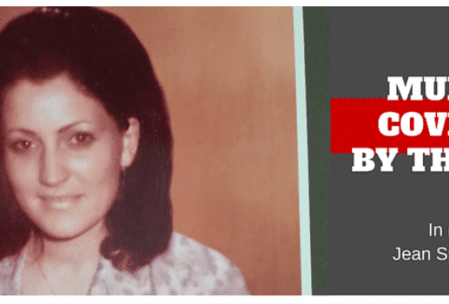
Comments are closed.